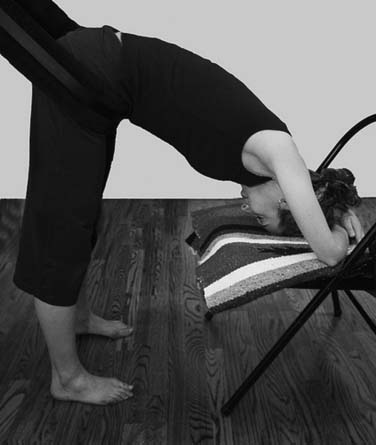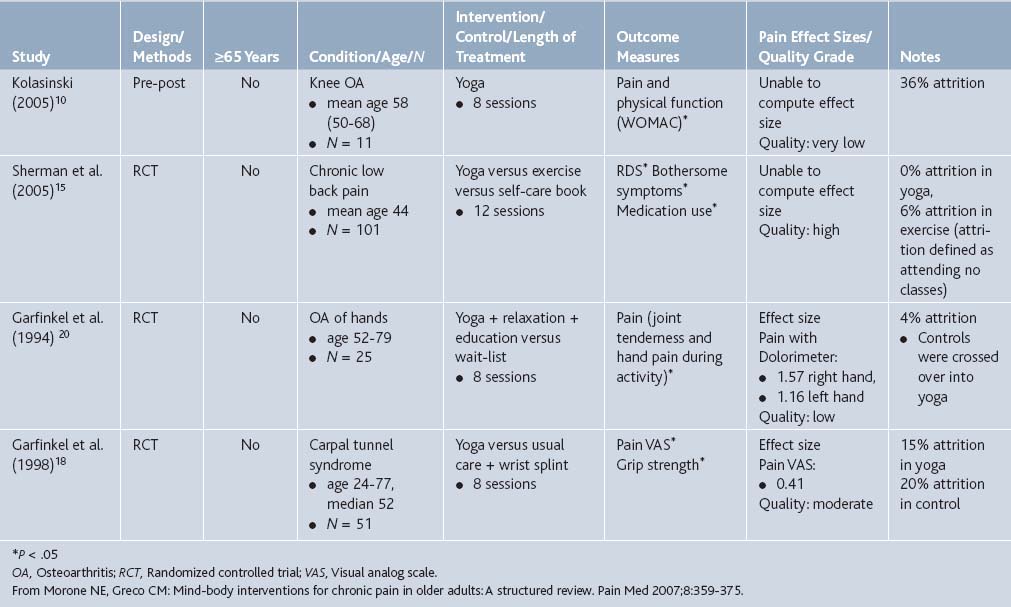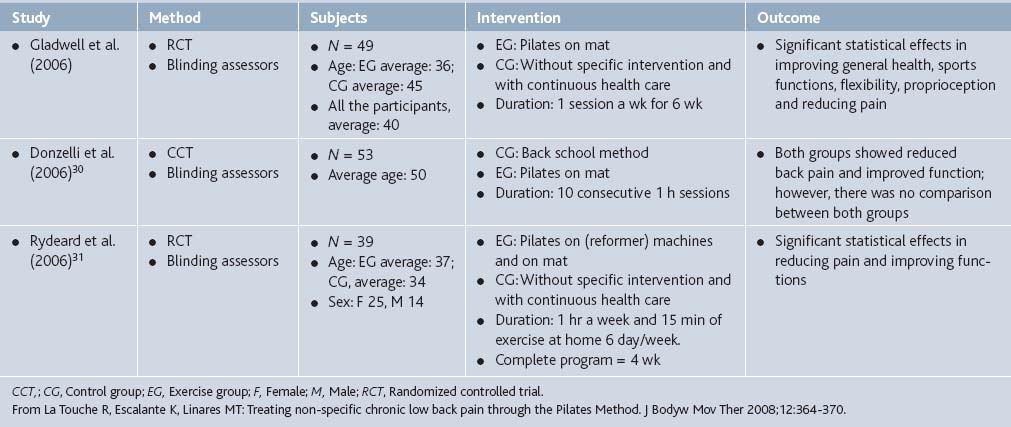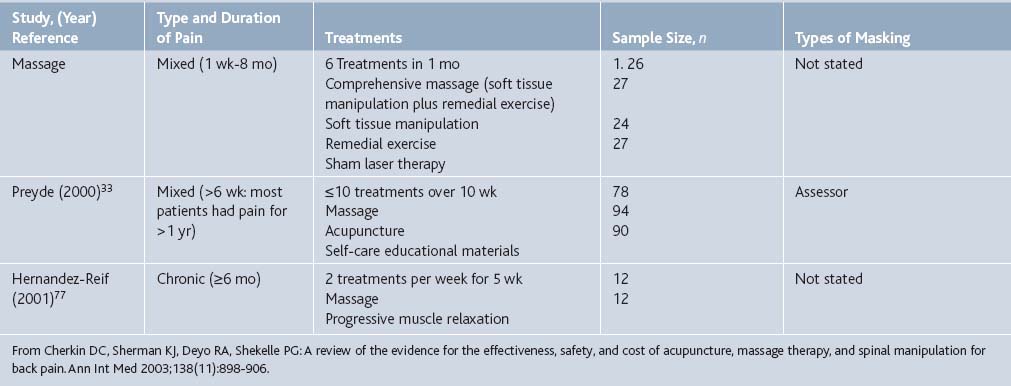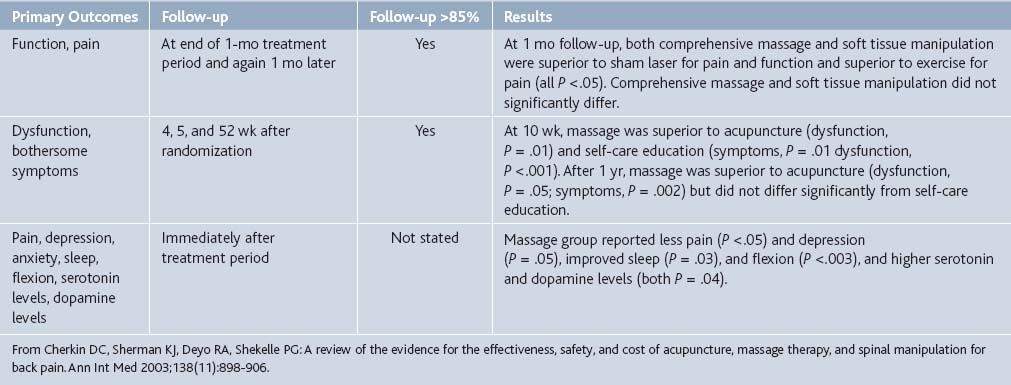21 Body Work and Movement Therapies
Yoga
Yoga is an Indian art created by the sage Patanjali, approximately 2000 years ago to “see things as they really are and achieve freedom from suffering.”1 The details of the meditative program of yoga were chronicled in the Yoga sutra, written by Patanjali. A partly philosophical work, the sutra explores the nature and reason for human suffering and offers yoga as a potential remedy. Patanjali explains yoga as a vehicle for connecting with the external world, as well as for understanding the internal world. Despite the spiritual nature of yoga, the art is nonsectarian; traditionally, yoga was passed on directly from teacher to student.2
Asana, or posture, is the third limb. This limb consists of specifically designed physical postures that effectively stimulate the body (Fig. 21-1). Such postures are often named after the nature, mythological being, or body part they resemble, such as “the Lotus,” “Hanumanasana,” and “headstand,” respectively.3 The postures allow for the fourth limb, Pranayama, or breath control. The limb consists of a refined control of drawing air into the body and expelling it to expand what is known as Prana (life-force). Pratyahara, sensory inhibition, is the fifth limb. It involves managing the senses to allow the body to use them to look inward.
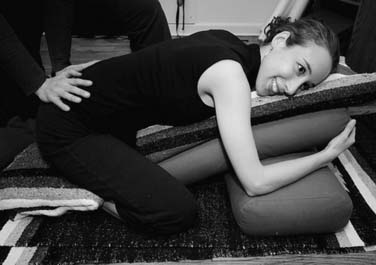
Figure 21-1 Modified child yoga position enhancing release of pelvic girdle and axial spine tension.
The next limb is Darana, or concentration. This limb involves steady concentration on a specific item without interruption. The seventh limb of yoga is Dhyana, meditation. Meditation is the ability to maintain one’s attention without being distracted. The final limb is Samadhi or ecstasy. This limb involves transcending oneself in all aspects and coming to understand ultimate truth.4
Yoga’s call for the specific control of body has allowed its’ practitioners to perform seemingly supernormal acts: “The voluntarily stopping and restarting of the heart, the holding of breath for extended periods, the ability to remain motionless for months or even years, and the prolongation of life itself are well-known examples.”5
Each Asana has its own respective benefits (Fig. 21-2). Four connected examples of Asanas include Sarvangasana, Halasana, Bhujangasana, and Matsyendrasana. Sarvangasana is the shoulder stand posture; it involves resting the body on the shoulders and neck. Generally, blood circulation is improved in this posture, allowing a large supply of blood to the upper extremities. In addition, the posture eliminates the stiffness caused by long periods of standing.
Halasana proceeds after Sarvangasana; the feet are positioned behind the head.6 This position completely stretches the spine and helps reduce constipation by increasing the movement of the intestines through compression. Bhujangasana is also known as the “cobra” posture and counteracts the forward bending of the previous two postures. Essentially, in this posture, the stomach lies to the ground with legs straight, while the neck is stretched backwards. As a result, the muscles of the neck are strengthened and the chest is stretched. Matsyendrasana continues the posture by allowing for the rotary flexion of the spine. In this Asana, the participant sits on the floor and brings the right heel against the perineum. The right hand then grasps the right knee, thereby allowing the body to twist. The lumbar muscles are stretched as a result of this position.7
A recent article in the Journal of Alternative and Complementary Medicine8 demonstrated the benefits of yoga on pain. Thirty-three veterans at the Veterans Administration Hospital in San Diego with chronic low back pain received weekly Anusara Yoga classes. After 10 weeks, the participants reported significant improvements in pain severity, with a mean rating of 70.94 out of 100 at baseline and 61.36 at follow-up (P < .001). There was also improvement on other parameters such as energy and depression (Table 21-1). Of note, these results reflect the thirty-three veterans who fully participated in the program, as 15 participants dropped out or were unavailable for follow-up after initial questionnaire.
At the Swami Vivekananda Yoga Research Foundation in India a randomized controlled trial (RCT) comparing the effect of a short-term intensive residential yoga program with physical exercise (control) on pain and spinal flexibility was conducted in subjects with chronic low-back pain.9 The intervention consisted of a 1-week intensive residential yoga program composed of Asanas designed for back pain, Pranayamas, meditation, and didactic and interactive sessions on philosophical concepts of yoga. The control group practiced physical exercises under a trained physiatrist and also had didactic and interactive sessions on lifestyle change. Hour-to-hour matching for the types of practices for the two groups was ensured (see Table 21-2). After 7 days, there was a significant reduction in pain scores (as measured by the Oswestry Disability Index) in the yoga group compared to the control group (P = .01; effect size 1.264).
In a pilot study of adults (mean age 59 years) with osteoarthritis of the knee where all participants received the intervention of yoga, Kolasinski and colleagues found statistically significant reductions in pain (a decrease of 47% over 8 weeks).10 The clinic-based intervention consisted of 90-minute sessions delivered weekly over an 8-week period. Of the 11 subjects enrolled, 7 (64%) completed at least five of the eight classes and underwent both pre- and postintervention assessments.
In an RCT conducted at West Virginia University School of Medicine, the investigators randomized 60 adults with chronic low back pain (mean age 48.3 years, low back pain for 11.2 ± 1.54 years) to weekly yoga classes (1.5 hours/week) or an education control group over 16 weeks.11 Pain was assessed using the Short Form-McGill Pain Questionnaire (SF-MPQ).12 The SF-MPQ measures present pain intensity with a standard horizontal 10 cm visual analog scale (VAS)13 and the Present Pain Index (PPI). The VAS is a bipolar line scale with the descriptive anchors of no pain on the left side of the line and worst possible pain on the right side of the line. The PPI is a rating scale that requires each patient to endorse their pain with one check from 0 representing no pain to 5 representing excruciating pain. Forty-two (70%) subjects completed the study. At 3-month follow-up, the control group VAS rating was 2.0, whereas for the yoga group it was 0.6 (P = .039). The PPI rating was also significantly less in the yoga group than the control (0.5 versus 1.1, respectively, P = .013). Additionally, significantly more people in the yoga group stopped or decreased use of pain medication than the control group.
A study at the Group Health Cooperative,14 a nonprofit, integrated healthcare system in Washington and Idaho, enrolled 101 primary care patients (mean age, 44 years) with chronic back pain and randomized them to receive either 12 weeks of yoga, 12 weeks of a structured exercise class, or an education only group (participants were given a book on self-care for back pain). The participants were followed-up at 6, 12, and 26 weeks with a telephone interview and were asked, among other things, to rate from 0 to 10 how bothersome their pain had been during the previous week. All groups had decreased bothersome symptom scores at 26 weeks (see Fig. 21-3). No significant differences in bothersome symptoms were found between any two groups at 12 weeks; at 26 weeks, the yoga group was superior to the book group with respect to this measure (mean difference,− 2.2 [CI, −3.2 to −1.2]; P < .001), however there were no significant differences between the yoga and exercise groups.
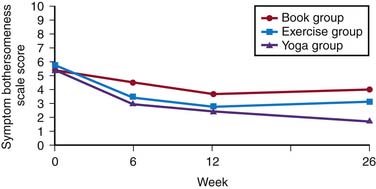
Figure 21-3 Mean symptom bothersome symptom scale scores at baseline, 6, 12, and 26 weeks by treatment group.
(Adapted from: Sherman KJ, Cherkin DC, Erro J, et al: Comparing yoga, exercise, and a self-care book for chronic low back pain: a randomized, controlled trial. Ann Intern Med 2005;143:849-856.)
At the University of Sao Paolo in Brazil 40 women with fibromyalgia were randomized to receive either relaxing yoga (RY) or relaxing yoga plus touch (RYT)—touch being the manipulative techniques of Tui Na.15 Both groups received weekly sessions for 8 weeks and showed improved pain scores. Touch addition yielded greater improvement during the treatment. Over time, however, RY patients reported less pain than RYT. These results suggest that a passive therapy may possibly decrease control over fibromyalgia symptoms.
Morone and colleagues16 conducted a structured review of eight mind-body interventions for older adults with chronic nonmalignant pain. Of the articles that met criteria of studying older adults (>50 years) with chronic pain, they found that yoga was significantly associated with pain reduction for low back pain, osteoarthritis, and carpal tunnel syndrome. See Table 21-3 for summaries of the included studies.
Researchers at the University of Rajasthan17 examined yoga’s impact on migraine in an RCT. Seventy-two patients (mean age, 34, females > males) who had been diagnosed with migraine without aura were assigned to attend yoga or self-care groups for 12 weeks. After this time, the yoga group was statistically significantly less on all parameters measured (P < .001): headache frequency (4.56 versus 10.18 days in the last month), average pain score (4.64 versus 7.81 out of 10) and duration of attacks (4.78 versus 6.42 hours). Additionally, on the SF-MPQ pain questionnaire, the yoga group was significantly less in overall intensity of pain (1.69 versus 3.97).
Garfinkel and colleagues18 conducted a randomized controlled multicenter trial of Hatha Yoga for patients with carpal tunnel syndrome, emphasizing upper body postures and relaxation. The control group was assigned to wear wrist splints for 8 weeks. Participation in the yoga program was for 60 to 90 minutes, two times per week for 8 weeks. Average pain intensity in the subjects in the yoga group, as measured by the VAS, decreased from 5.0 to 2.9 after 8 weeks (P = .02), whereas pain did not significantly decrease in the control group. The authors of a follow-up article theorized that yoga may decrease wrist and hand pain by improving posture and reducing compression on the median nerve.19
Garfinkel also examined the effect of yoga on osteoarthritis pain.20 He conducted an RCT on patients with osteoarthritis who received either eight weeks of yoga (one 60-minute session per week focusing on stretching and strengthening of the upper body) or no therapy. The yoga-treated group improved significantly more than the control group in pain intensity during activity and tenderness.
In addition to musculoskeletal pain, yoga has been found to exhibit some relief in people with cancer pain. Researchers at Duke University21 conducted a pilot study of 21 women with metastatic breast cancer and who received the Yoga Awareness Program for 8 weeks. The Yoga Awareness Program was specifically designed for metastatic breast cancer patients and included gentle yoga postures, breathing exercises, meditation, didactic presentations, and group interchange. Lagged analyses of length of home yoga practice showed that on the day after a day during which women practiced more, they experienced significantly lower levels of pain.
Yoga is an effective treatment for pain as supported by a large body of literature; its benefits have been recognized by major medical societies. According to a report issued by the American College of Physicians and the American Pain Society,22 yoga is a valid consideration for chronic or subacute low back pain in patients who have not improved with self-care options. This recommendation is largely based on the Group Health Cooperative study mentioned previously. The report grades the level of evidence as “Fair” with a moderate net benefit for Viniyoga, but “Poor” with unknown benefit for Hatha Yoga. It is unclear the mechanism by which yoga improves pain, but is likely due to a combination of stretching and physical movement with relaxation and mental focus. It is important to take note that several of these studies are confounded by noncompliance and drop-out. Yoga may relieve pain but only if those people with pain are able to and comply with practicing it.
Pilates
Pilates is a system of psychophysical exercise that was created by Joseph Pilates. It emphasizes good posture, proper breathing, body awareness, and graceful movement to better condition the body to prevent it from being prone to injury.23 Pilates was once associated with being the training method of the elite and famous. Since the 1980s, however, the training method has entered into the mainstream.
The history of Pilates began in the early 1900s while Joseph Pilates was interned in England with other German nationals. Originally working as a self-defense instructor for Scotland Yard, Pilates expanded and developed his ideas during his internment. In one particular case, he attached springs to hospital beds for immobile patients, allowing them to exercise. After the war, Pilates’ techniques become popular in the German dancing community. However, Pilates eventually decided to immigrate to the United States in 1926. By 1960, Pilates had married and worked as an instructor for ballerinas from the New York City Ballet. The popularity of his training expanded across the country. After Pilates’ death in 1967, his students, including Romana Kryzanowska, Ron Fletcher, Kathy Grant, and Lolita San Miguel, opened their own Pilates’ styled exercise studios around the country and in Puerto Rico. Notably, Ron Fletcher’s studio catered to Hollywood celebrities, greatly increasing the popularity of Pilates.24
The execution of Pilates varies depending on the equipment available as well as the aim of the user. Generally, mats and reformers, a system of springs and ropes for resistance, are most common. Variations of the exercise range from athletes who want a specific form of improvement, including running faster or throwing farther, to lay people looking to develop strength and coordination.25
In Maher’s 2004 review,26 he concluded that there is insufficient scientific evidence to justify the effectiveness of Pilates (see Table 21-1). However, randomized clinical studies of the effect of Pilates on pain have become more common over the past few years, three of which were analyzed by La Touche and colleagues27 and deemed to be of satisfactory methodology (Table 21-4). The evaluation of the methodological quality of the studies was carried out using two instruments, the PEDro28 and Jadad Scales.29 The PEDro Scale includes 11 items to evaluate four fundamental methodological aspects of a study such as the random process, the blinding technique, group comparison, and the data-analysis process. All three controlled trials included in La Touche’s analysis indicated positive effects of Pilates for alleviating chronic lower back pain.
The Donzelli study30 (see Table 21-4), an RCT, showed significant reduction in back pain after daily therapy of Pilates or back school for 10 days. Pain was assessed using the Visual Analog Scale and decreased from an average score of 6 at pretreatment to 4 at 6-month follow-up. Although Pilates was not compared directly to back school treatment, the Pilates group showed better compliance and subjective response to treatment.
The Rydeard study (see Table 21-4),31 albeit small, had convincing results. After 4 weeks of Pilates practice, the posttest adjusted mean in lower back pain intensity in the specific-exercise-training group was 18.3 out of 101 (95% CI, 11.8 to 24.8), compared to 33.9 out of 101 (95% CI, 26.9 to 41.0) in the control group who received the usual care, defined as consultation with a physician and other specialists and healthcare professionals, as necessary (P = .002). After 12 months, however, there was no longer a significant difference in lower back pain between the two groups.
Beyond the aforementioned articles, there have been few other articles examining the effectiveness of Pilates in pain relief. A pilot study by Keays and colleagues32 evaluated four women with breast cancer status post-axillary dissection and radiation therapy. Each participant received 1-hour Pilates exercise sessions three times per week for 8 weeks. Pain was assessed using the Brief Pain Inventory-Short Form (BPI),33 a 15-item, self-administered tool developed for use in patients with cancer. Results were inconclusive. Except for participant 1, high levels of pain at the study outset were not reported. Average pain level decreased by 2 to 11 points from baseline to intervention for participants 1, 3, and 4 but increased by 1 point for participant 2.
Massage
Massage is the stimulation of and applied pressure on soft tissue for therapeutic purposes, and is one of the oldest forms of medical treatment in the world, with origins in various societies. Chinese writings dating back to 2700 BC and 2598 BC mention massage in religious documents and a medical work, respectively. The depictions of massages were found on the wall of an Egyptian physician’s tomb in Saqqara circa 2330 BC. Massage was also mentioned and approved in both the Indian medical work, Ayurveda, written around 1800 BC and by Hippocrates in 400 BC in the book On Articulations.
Modern massage came into effect when the practice became more systematic. In 1863, the French publication of Estradere’s Du Massage, “systematically classified each massage technique according to the bodily system affected.” This influenced the rise of scientific massage techniques.34 Such techniques include the Swedish massage techniques developed by Per Henrik Ling in the early nineteenth century.
In the United States, modern scientific massage therapy was introduced in the mid 1800s. In the United States, massage techniques were used by physicians until the early 20th century. When the pharmaceutical revolution occurred in the 1940s, massage therapy became less acceptable and was categorized as an alternative form of health care. In the 1960s, physical therapy began to use massage for the treatment of musculoskeletal impairments and other physical impairments. During the same era, the growth in the movements toward emphasizing human psychology and spirituality greatly increased massage therapy’s popularity. Following the 1960s, massage therapy eventually became incorporated into the “normal,” healthy lifestyle. Nursing and physical therapy have come to reincorporate massage techniques including simple backrubs, reflexology, therapeutic touch, and aromatherapy massage. Presently, surveys in the United States have indicated the growing popularity of massage; it is one of the most commonly used therapies for both the general population as well as individuals with disabilities, and it is one of the top physician referrals for alternative therapies.35
Several common stroke techniques can be found among the myriad of massage techniques. These include, effleurage, friction, pressure, petrissage, vibration, and percussion. Effleurage involves rhythmic and gentle skin contact. Generally, the palm is used for larger body surfaces, whereas the fingers are used for smaller body surfaces. In the friction stroke technique, pressure is applied to one area with the thumbs or fingers in moderately. The pressure stroke is, similar to the friction stroke, except that pressure strokes are made with the hands. Petrissage, also known as kneading, involves lifting and holding skin and the underlying muscle. The tissues are pushed against the bone. Tissues are supported by one hand while kneading is done with the other hand. Kneading is generally limited to areas of the body with large muscles mass. Vibration strokes involve the use of continuous motion. For percussion strokes, the wrist is used for tapping areas of the body.36
Massage therapy to treat pain is extremely common in the United States, however, exact numbers are unclear. Sherman and others surveyed randomly selected acupuncturists, chiropractors, and massage therapists in two states.37 Back pain was the most common reason for visits to each of these providers, with chronic back pain representing about 12% of visits to massage therapists.
Wells and coworkers38 studied use of complementary and alternative therapies in 189 women with non–small-cell lung cancer. Massage was used by 6.9% of participants, most commonly for pain (54.8%). Women who were younger, experienced more symptoms, and lived on the West Coast or in the South (versus the Northeast) were more likely to use complementary and alternative therapies.
In a nationally representative survey that sampled 2055 adults, Wolsko and colleagues39 discovered that 54% of those reporting back or neck pain in the last 12 months used complementary and alternative therapies, including 14% who used MT. According to Brett and colleagues, 15% of midlife U.S. women have used massage and chiropractic medicine, most commonly for pain.40 Palinkas and Kabongo41 surveyed 542 patients attending sixteen family practice clinics belonging to a community-based research network in San Diego, California, and found that 17.2% used MT. The results of a survey and interviews of older adults showed that the most prevalent motivation for using complementary and alternative therapies was pain relief (54.8%), and that MT was used by 35.7%.42 Prevalence of MT use in a large military family practice clinic was found to be 36%, most commonly used for back or other musculoskeletal pain.43
In a telephone interview survey of Chicago adults 45 years of age or more, Feinglass and others44 discovered that more than half of the respondents used complementary and alternative therapies, most commonly MT and relaxation techniques. Similarly, more than half of traumatically injured spinal cord patients with shoulder pain received MT or physical therapy.45
In terms of the benefits of massage, Ernst evaluated systematic reviews of massage therapy (MT) and chiropractic effects on reduction of any type of pain.46 Two reviews were found, and there was not unequivocal evidence for effectiveness of MT in controlling musculoskeletal or other pain. A meta-analysis of 37 studies that used random assignment concluded that single applications of MT did not reduce immediate assessment of pain, whereas multiple applications reduced delayed assessment of pain.47
Back and colleagues described a pilot program to evaluate the efficacy of employer-funded on-site massage therapy on job satisfaction, workplace stress, pain, and discomfort.48 Twenty-minute massage therapy sessions were provided weekly for 4 weeks. Evaluation demonstrated possible improvements in job satisfaction, with initial benefits in pain severity (as measured by the Brief Pain Inventory49), and the greatest benefit for individuals with preexisting symptoms. Pain severity decreased by about 2% when initially measured after the 4-week massage period. However, at follow-up of 6 weeks and 12 weeks, pain severity actually incrementally increased. This was thought to be due to the MT making participants more aware of their bodies and pain, thereby causing them to report higher pain scores.
Use of MT in neck, back, and other musculoskeletal pain has been studied extensively. A review by Trinh and others50 concluded that there is limited evidence that MT is less effective than acupuncture in chronic mechanical neck pain. Ezzo and colleagues51 analyzed 19 trials of MT in neck pain, with 12 of 19 receiving low-quality scores. Descriptions of the massage intervention, massage professional’s credentials, or experience were frequently missing. Six trials examined massage as a stand-alone treatment. The results were inconclusive. Results were also inconclusive in 14 trials that used massage as part of a multimodal intervention because none were designed such that the relative contribution of massage could be determined.
Cherkin and co-authors52 reviewed Medline, Embase, and the Cochrane Controlled Trials Register, and included three RCTs that evaluated massage and reported that this therapy is effective for subacute and chronic back pain and superior to certain other therapies (Tables 21-5 and 21-6). For example, Hernandez-Reif compared massage therapy to muscle relaxation. Twelve patients with chronic low back pain were randomly assigned to each of these treatments. After ten 30-minute sessions over 5 weeks, massage was found to be superior to progressive muscle relaxation for pain, depression, flexion, and sleep.
Similarly, Furlan and colleagues53 conducted a systematic review of Medline, Embase, Cochrane Controlled Trials Register, HealthSTAR, CINAHL, and dissertation abstracts describing use of MT for lower back pain. Nine publications reporting on eight randomized trials were included. Three had low and five had high methodological quality scores. Massage was compared with an inert treatment (sham laser) in one study that demonstrated massage was superior, especially if given in combination with exercises and education. In the other seven studies, massage was compared with different active treatments. They showed that massage was inferior to manipulation and transcutaneous electrical nerve stimulation; massage was equal to corsets and exercises; and massage was superior to relaxation therapy, acupuncture, and self-care education. The beneficial effects of massage in patients with chronic LBP lasted at least 1 year after the end of the treatment. One study comparing two different techniques of massage concluded in favor of acupuncture massage over classic (Swedish) massage.
A review of several modalities including MT in the management of painful musculoskeletal disorders54 concluded that, although evidence from basic science research suggests many of the therapies could have potentially therapeutic effects, there is limited high-quality evidence from randomized clinical trials to support the therapeutic effectiveness of these therapies.
Best and colleagues reviewed evidence for using massage for muscle and soft tissue pain and weakness after intense exercise.55 Analysis of 27 studies that met inclusion criteria led authors to conclude that, although case series provide little support for the use of massage to aid muscle recovery or performance after intense exercise, randomized controlled trials provide moderate data supporting its use to facilitate recovery from repetitive muscular contractions. It also appears that the experience of the massage therapist may be directly related to effectiveness of the MT in relieving muscle soreness after a 10 km race.56
Dryden and associates57 reviewed evidence for using massage in orthopedic problems and concluded that massage therapy may be effective for orthopedic patients with low back problems and potentially beneficial for patients with other orthopedic problems. Massage therapy appears to be safe, to have high patient satisfaction, and to reduce pain and dysfunction. In a randomized, double blind, placebo controlled trial of 140 subjects with knee osteoarthritis, physiotherapy including MT appeared no more effective in reducing pain at 12 and 24 weeks than regular contact with a therapist.58
Several investigators have studied use of massage in cancer pain. Ferrell-Torry and Glick59 administered thirty minutes of therapeutic massage on two consecutive evenings to nine hospitalized males diagnosed with cancer and experiencing cancer pain. Massage therapy significantly reduced the subjects‘ level of pain perception and anxiety. In addition to these subjective measures, all physiologic measures (heart rate, respiratory rate, and blood pressure) tended to decrease from baseline, providing further indication of relaxation. Building on the work of these authors, Grealish and colleagues60 administered 10-minute foot massage (5 minutes per foot) to 87 subjects hospitalized with cancer and found a significant immediate effect on the perceptions of pain, nausea, and relaxation when measured with a visual analog scale.
Stay updated, free articles. Join our Telegram channel

Full access? Get Clinical Tree


